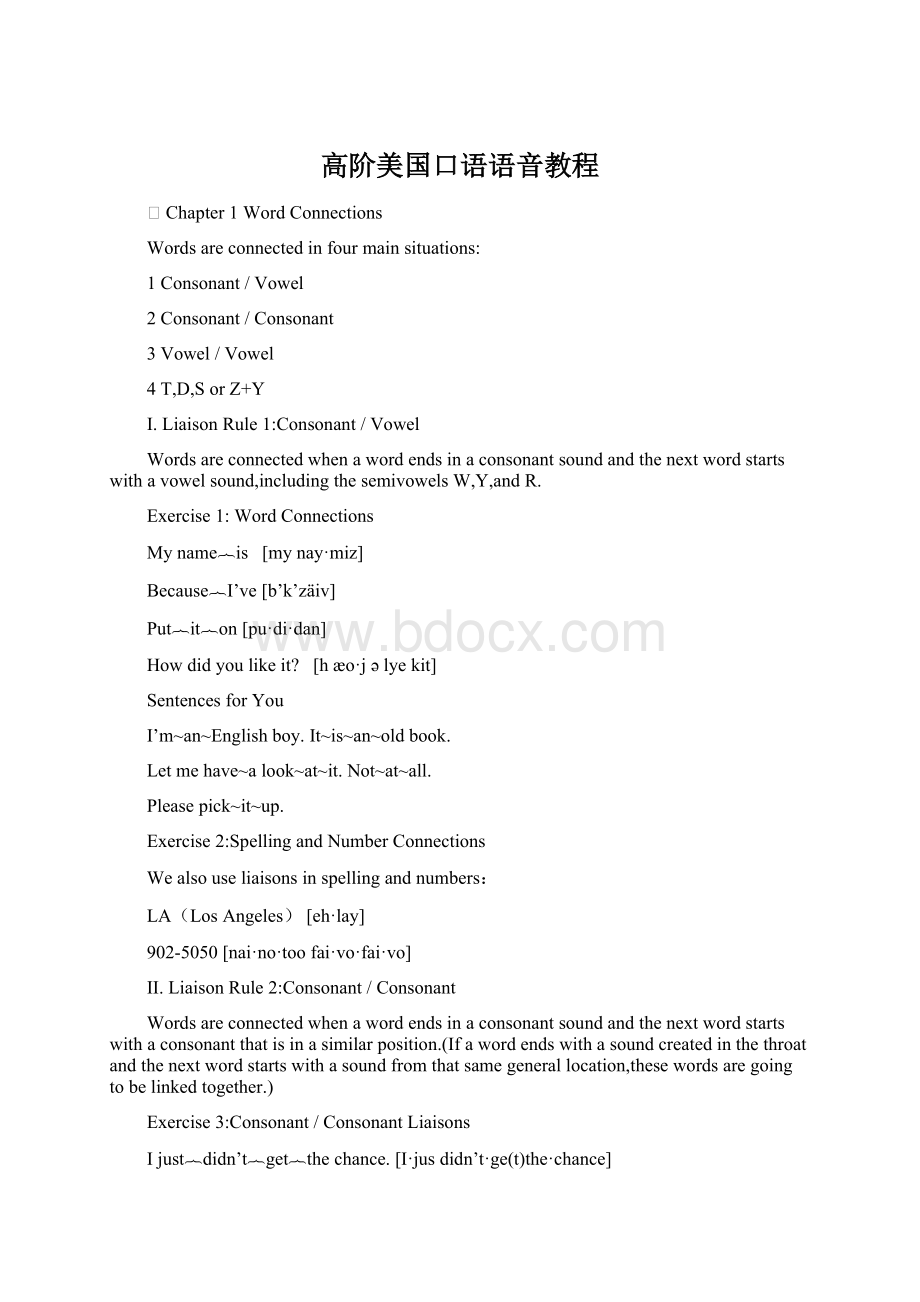高阶美国口语语音教程Word文档格式.docx
《高阶美国口语语音教程Word文档格式.docx》由会员分享,可在线阅读,更多相关《高阶美国口语语音教程Word文档格式.docx(12页珍藏版)》请在冰豆网上搜索。

SentencesforYou
I’m~an~Englishboy.It~is~an~oldbook.
Letmehave~alook~at~it.Not~at~all.
Pleasepick~it~up.
Exercise2:
SpellingandNumberConnections
Wealsouseliaisonsinspellingandnumbers:
LA(LosAngeles)[eh·
lay]
902-5050[nai·
no·
toofai·
vo·
fai·
vo]
II.LiaisonRule2:
Consonant/Consonant
Wordsareconnectedwhenawordendsinaconsonantsoundandthenextwordstartswithaconsonantthatisinasimilarposition.(Ifawordendswithasoundcreatedinthethroatandthenextwordstartswithasoundfromthatsamegenerallocation,thesewordsaregoingtobelinkedtogether.)
Exercise3:
Consonant/ConsonantLiaisons
Ijust︷didn’t︷get︷thechance.[I·
jusdidn’t·
ge(t)the·
chance]
I’vebeenlate︷twice.[I’vbinla(t)twice]
Race︷track[ray·
stræ
k]
Intheprecedingexamplesyoucanseethatbecausetheending[st]ofjustandthebeginning[d]ofdidn’taresoneateachotherinthemouth,it’snotworththeefforttostartthesoundalloveragain,sothejustflowintoeachother.
Ⅲ.LiaisonRule3:
Vowel/Vowel
Whenawordendinginavowelsoundisnexttoonebeginningwithavowelsound,theyareconnectedwithaglidebetweenthetwovowels.Aglideiseitheraslight[y]soundoraslight[w]sound.
Exercise4:
Vowel/VowelLiaisonPractice
Go︷away.[Go(w)away.]
I︷alsoneedthe︷otherone.[I(y)alsoneedthee(y)otherone.]
She︷isn’t.[she(y)isn’t]
Who︷is?
[who(w)iz]
What’scalledglide?
The[w]soundand[y]soundarecalledglides.Therearegoingtolinkstovowelsoundwhentheymeettogether.A[w]or[y]quitenaturallyleadsintothenextvowelsound.[Go(w)away]/[she(y)isn’t].Youdon’twanttosayGo…awayandbreaktheundercurrentofyourvoice.Runitalltogether.
Ⅳ.LiaisonRule4:
T,D,SorZ+Y
WhentheletterorsoundofT,D,S,orZisfollowedbyawordthatstartswithY,oritssound,bothsoundsareconnected.TheselettersandsoundsconnectnotonlywithY,butthedosoaswellwiththeinitialunwritten[y].
Exercise5-1:
T+Y=CH
What’syourname?
[wəchername]
Can’tyoudoit?
[kæ
ntchewdo(w)it]
Haven’tyou?
No,notyet.[hæ
venchew?
nou,nä
chet]
Exercise5-2:
D+Y=J
Didyouseeit?
[didjəsee(y)it]
Couldyoutellme?
[kü
jətellmi]
Didyoufindyourkeys?
[didjəfinejerkeez]
Exercise5-3:
S+Y=SH
Yes,youare.[yeshuare]
Blessyou!
[blesshue]
Lethimgasyourcarforyou.[leddimgæ
shiercä
rfryou]
Exercise5-4:
Z+Y=ZH
How’syourfamily?
[hæ
ozhierfæ
mlee]
Who’syourfriend?
[hoozhierfrend]
Where’syourmom?
[wεrzh’rmä
m]
Wordsareconnectedintheseadditionalsituations:
1/r/+vowels
2VoicedConsonants+/h/
Ⅰ.AdditionalRule1:
/r/+Vowels
WhenawordendswithletterRorREthenitwillnotbepronouncedinBritishEnglish.Butwhenit’sfollowedbyawordstartswithavowelsoundandtheyareinthesamewordsgroup,weusuallylinkthemup.
Exercise6:
Thereisaboy.[ð
eə`rizə`bɔi]
Forexample[fərig`zä
mpl]
Notes:
1).Ifthereisa/r/soundthatisbeforeletterRorReinoneword,thenwedon’tlinkitwithanyfollowingvowelsound.Bytheway,theletterRorREmustbesilent.
Example:
It’sarareanimal.[itsə'
reə`æ
niml]
2).Whenthereisapossiblepausebetweentwowords,letterRorREwillbenotbepronouncedandwedon’tlinkthemupeventhoughwedon’tpracticallypausetherewhilespeaking.
Heopenedthedoorandwalkedin.
TheAdditional/r/Sound
Wealsolinktwovowelsounds(EXCEPTā、ē、ī、ō、ū)withanextra/r/whenthetwovowelsoundsareinonewordsgrouptoavoidpronouncingseparately.
Example
Theideaofit.[ð
iai’diərəvit]
Ⅱ.AdditionalRule2:
VoicedConsonants+/h/
The/h/isregardedasasoftconsonant(nottoohard,like/t/).Whenawordisendedwithaconsonantsoundandfollowedbya/h/sound,theycouldformtheliaison.
Exercise7:
Tellhim[tellim]
Callhim[cä
llim]
Isn’the?
[iznti]
Chapter2IntonationandStress(rhythm)
ThreeWaystoMakeIntonation
✧Justgetlouderorraisethevolume.
✧Streeeeechthewordoutorlengthenthewordthatyouwanttodrawattentionto.
✧Changepitch.
StaircaseIntonation
StaircaseIntonationiswidelyusedinAmericanEnglish.Wegoupanddownstaircases.Westarthighandendlow.
Weupstair
goandcases
down
Everytimewewanttostressawordoranidea,wejuststartanewstaircase.Thatsoundssimpleenough,butwhenandwheredoyoustartanewstaircase?
StatementIntonationwithNouns
Intonationorpitchchangeisprimarilyusedtointroducenewinformation.Thismeansthatwhenyouaremakingastatementforthefirsttime,youwillstressthenouns.
Dogs
Bones.
eat
Exercise:
NounIntonation
1.Dogseatbones.2.Mikelikesbikes.
3.Jerrymakesmusic.4.Theboysneedsomehelp.
StatementIntonationwithPronouns
Whenwereplacethenounswithpronouns(i.e.,oldinformation),stresstheverb.
eat
Theythem.
Aswehaveseen,nounsarenewinformation;
pronounsareoldinformation.Inanutshell,thisarethetwobasicintonationpatterns:
Dogsbones
eatTheythem
NounandPronounIntonation
Inthefirscolumn,stressthenouns.Inthesecondcolumn,stresstheverb.
1.BobseesBetty.1.Heseesher.
2.Jeansellsbombs.2.Shesellsthem.
3.ThemurdererkilledSisterFone.3.Hekilledawoman.
FourMainReasonsforIntonation
1.NewInformation
2.Opinion
3.Contrast
4.Can’t
Dependingonthesituation,awordmaybestressedforanyofthefollowingreasons.
NewInformationOpinionContrast“Can’t”
1.NewInformation
Itsoundslikerain.
Rainisthenewinformation.It’sthemostimportantwordinthatsentenceandwecouldreplaceeverythingelsewithduh-duh-duh.Duh-duh-duhrainwillstillletyougetyourpointacross.
Duhray
duhayn
duh
Itsoundslikerain,butIdon’tthinkitis.
Inthiscase,intonationmakesthemeaningtheoppositeofwhatthewordssay:
Itlookslikeadiamond,butIthinkit’sacrystal.Itfeelslike…Ittasteslike…Theseexamplesallgivetheimpressionthatyoumeantheoppositeofwhatyoursensestellyou.
▼Practicetheintonationdifferencebetweennewinformationandopinion:
Itsoundslikerain,(It’srain)
Itsoundslikerain.(butit’snot.)
Helikesrain,buthehatessnow.
Likeandhatearecontrastedandarethestrongerwordsinthesentence.
Itcan’trainwhenthere’renoclouds.
Contractions(shouldn’t,wouldn’t)andnegatives(no,not,never)areimportantwordssincetheytotallynegatethemeaningofasentence,buttheyarenotusuallystressed.Can’tistheexception.
Exercise:
PitchandMeaningChange
Paycloseattentiontothechangesinpitchthatyoumustmaketoconveythedifferentmeaningsintended.Thewordstobestressedareindicatedinboldface.
1.Itsoundslikerain.
2.Itsoundslikerain.
3.Helikesrain,buthehatessnow.
4.ItseemsthatSisterFonegotmarried.
IntonationContrast
Belowaretwosentences—thefirstisstressedonthemostcommon,everydayword,book.Ninetimesoutoften,peoplewillstressthesentencetinthisway.Thesecondsentencehasalesscommon,butperfectlyacceptableintonation,sincewearemakingadistinctionbetweentwopossiblelocations.
NormalintonationWhere’sthebook?
It’sonthetable.
ChangedintonationIsthebookonthetableorunderit?
It’sonthetable.
VariableStress
Noticehowthemeaningofthefollowingsentencechangeseachtimewechangethestresspattern.Youshouldbestartingtofeelincontrolofyoursentencesnow.
1.Whatwouldyoulike?
Thisisthemostcommonversionofthesentence,anditisjustasimplerequestforinformation.
2.Whatwouldyoulike?
Thisistosingleoutanindividualfromagroup.
3.Whatwouldyoulike?
You’vebeendiscussingthekindsofthingshemightlikeandyouwanttodeterminehisspecificdesires:
“Nowthatyoumentionit,whatwouldyoulike?
”
Or
Hehasrejectedseveralthingsandalittleexasperated,youask,“Ifyoudon’twantanyofthese,whatwouldyoulike?
4.Whatwouldyoulike?
Youdidn’thearandyouwouldlikethespeakertorepeatherself.
Youcan’tbelievewhatyouheard:
“I’dlikestrawberryjamonmyasparagus.”—“Whatwouldyoulike?
Chapter3ReducedSound
ReducedSoundAre“Valleys”
Americanintonationismadeupofpeaksandvalleys—topsofstaircasesandbottomsofstaircases.Tohavestrongpeaks,youwillhavetodevelopdeepvalleys.Thesedeepvalleysshouldbefilledwithallkindsofreducedvowels,oneinparticular—thecompletelyneutralschwa.
Syllablesthatareperchedatopapeakorastaircasearestrongsounds;
thatis,theymaintaintheiroriginalpronunciation,Ontheotherhand,syllablesthatfallinthevalleysoronalowerstairstepareweaksounds;
thustheyarereduced.Somevowelarereducedcompletelytoschwas,averyrelaxedsound,whileothersareonlytoneddown.
Intonationisthepeakandreducedsoundsarethevalleys.Inthefollowingexercise,workwiththisidea.Smallwordssuchasarticles.prepositions,pronouns,conjunctions,relativepronouns,andauxiliaryverbsarelightlyskimmedoverandalmostnotpronounced.
ReducedSounds
LooksLike…SoundsLike…
Totoday[t’day]
Uset’ortətowork[t’wrk]
Soundtoreplaceto.
Someocc